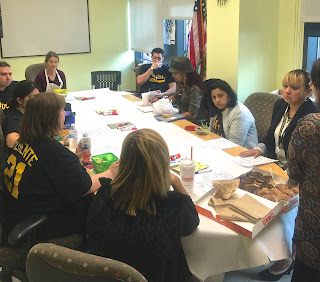 The idea for this quilt first arose after the success of the large, collaborative paper hanging sculpture, Racimo of Reflection, specifically at the All Paterson Student Art Exhibition in March 2016. LINK Creating Racimo of Reflection collectively inspired teachers to brainstorm a second collaborative STEAM project and Art PIR Triada Samaras encouraged the teachers to think outside the box.
The idea for this quilt first arose after the success of the large, collaborative paper hanging sculpture, Racimo of Reflection, specifically at the All Paterson Student Art Exhibition in March 2016. LINK Creating Racimo of Reflection collectively inspired teachers to brainstorm a second collaborative STEAM project and Art PIR Triada Samaras encouraged the teachers to think outside the box.
The idea for a "quilt" arose when art teacher Wendy Roche created the first “prototype” of a quilt piece, inspiring the rest of the teachers to think creatively with her. Teachers decided that any classroom who wished could produce a quilt square with their students in the classrooms. In addition, teachers decided that each square would communicate something about their subject using art materials. The quilt- project would moreover be a way to de-stress the students after strenuous testing this month, e.g. the PARCC Assessment.
Technology teacher Janette Selino suggested that the quilt squares be entered into a school-wide competition for an end of year prize. (Enrollment in this competition will be strictly voluntary.) In the past few weeks, teacher interest and participation are quickly growing. Teachers that have not yet participated in a STEAM project at NRC are now excited to join the new STEAM collaboration. More quilt news to come!

Above Left;
Colorful chart created by art teacher Wendy Roche to illuminate the infinite possibilities using folded paper on a quilt piece to achieve a wide variety of visual effects.
Sketch above by art teacher Wendy Roche who first envisioned the quilt to be a sort of tapestry.
Ms. Monique Aramayo, art teacher has been doing a math/art project with her students. Teaching them about radial symmetry and the mathematical components of a symmetrical circle pattern, Ms. Aramayo has encouraged her students to draw with pencil, then paint with tempera to create these extraordinary paintings.

 Taken together as a whole these radial symmetry paintings resemble a large rug or beautiful wall hanging.
Taken together as a whole these radial symmetry paintings resemble a large rug or beautiful wall hanging.Students worked on these radial symmetry paintings with paints and papers provided by the Geraldine R. Dodge STEAM grant.



In another new technology/art STEAM project, Ms. Monique Aramayo (pictured above) demonstrates the use of technology to assess her art students using an app named Plickers. This powerful tool allows teachers to collect real-time formative assessment data without the need for student devices. Below are the materials created by Ms. Aramayo for her students to use when she is collecting data with Plickers.
In the “Basket of Math” project (see images below) , math teacher Ms. Vancheri collaborated with art teacher Ms. Roche to create this colorful and artistic basket of equations. Ms. Vancheri had students utilize the Pythagorean Theorem to determine unknown side lengths of right triangles to solve mathematical problems. (See rubric below.) In addition math students wrote their equations onto colorful egg shapes. With the help of art teacher Ms Roche, a delightful handwoven basket was created, making the math wall visually as well as mathematically inspiring.
In the lobby of NRC, 8th grade algebra teacher Ms. Natalie Diaz (pictured below) created a spectacular bulletin board celebrating Albert Einstein and National Pi Day. Her students worked with the Sierpinski Triangle (see below) and created new formations that were placed onto this bulletin board.

The Sierpinski Triangle is a mathematically generated pattern that can be reproducible at any magnification or reduction. It is named after the Polish mathematician Waclaw Sierpiński but appeared as a decorative pattern many centuries prior to the work of Sierpiński. LINK
Ms Diaz also taught her students about the Menger Sponge (see above). In mathematics, the Menger sponge (also known as the Menger universal curve) is a fractal curve. It is a three-dimensional generalization of the Sierpinski carpet, though it is slightly different from a Sierpinski Sponge. The Menger sponge simultaneously exhibits an infinite surface area and zero volume. LINK

In addition several fabulous STEAM bulletin boards have been recently created throughout NRC by teachers of various disciplines. Below, science and social studies teacher Ms. Munem explains how her interactive "Renewable vs. Non-Renewable Energy Sources" bulletin board combines art and science.

In addition several fabulous STEAM bulletin boards have been recently created throughout NRC by teachers of various disciplines. Below, science and social studies teacher Ms. Munem explains how her interactive "Renewable vs. Non-Renewable Energy Sources" bulletin board combines art and science.























No comments:
Post a Comment
Note: Only a member of this blog may post a comment.